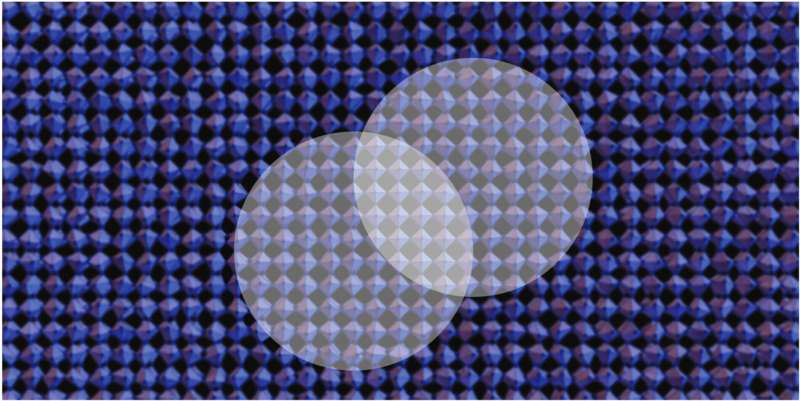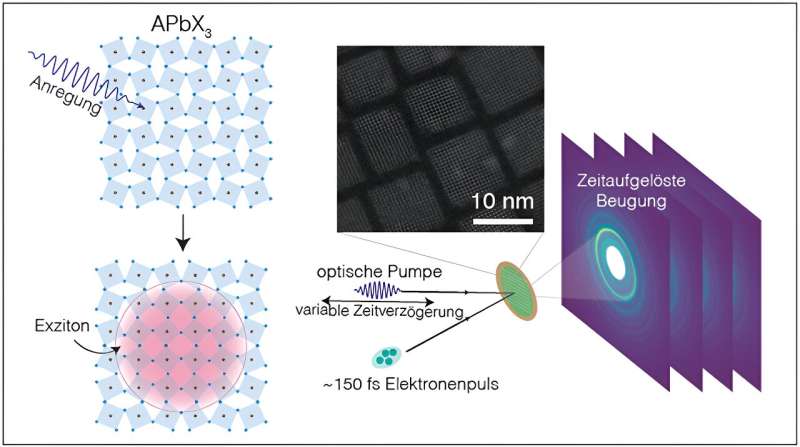This article has been reviewed according to Science X's editorial process and policies. Editors have highlighted the following attributes while ensuring the content's credibility:
fact-checked
peer-reviewed publication
trusted source
proofread
Researchers show excited electrons straightening the skewed lattice of perovskite nanocrystals

Researchers from ETH Zurich, Empa and Stanford have taken snapshots of the crystal structure of perovskite nanocrystals as it was deformed by excited electrons. To their surprise, the deformation straightened out the skewed crystal structure rather than making it more disordered.
Many a scientific and technical problem could be solved easily if it were possible to look inside a material and watch its atoms and electrons wiggle about in real-time. In the case of halide perovskites, a class of minerals that has become very popular in recent years for their use in technologies ranging from solar cells to quantum technologies, physicists have long tried to understand their excellent optical properties.
A team of researchers led by Nuri Yazdani and Vanessa Wood at ETH Zurich, and Aaron Lindenberg at Stanford, along with colleagues at Empa in Dübendorf, have now made significant progress toward our understanding of perovskites by studying the motion of atoms inside nanocrystals with a time resolution of a few billionths of a second. They recently published their findings in Nature Physics.
"Halide perovskites are great for many opto-electronic applications," says Yazdani. "But it is in some ways puzzling how this class of materials can exhibit such outstanding optical and electronic properties." Perovskites are minerals that have the same type of crystal structure as calcium titanate (CaTiO3), the "original" perovskite.
Researchers knew that when perovskites absorb light, electrons that are excited to higher energies couple strongly to phonons inside the material. Phonons are collective vibrations, similar to sound waves, of the atoms in a crystal. "Often one can treat the average position of each atom inside a crystal as fixed, but that is no longer possible when an optical excitation of an electron leads to a large reorganization of the crystal lattice," Yazdani explains. The question the researchers had to answer was, therefore: how do excited electrons in perovskites change the shape of the crystal lattice?

Looking inside nanocrystals
To take a peek inside a perovskite (formamidinium lead bromide) synthesized at Empa by Maryna Bodnarchuk and ETH professor Maksym Kovalenko, the researchers used an ultrafast electron diffraction beamline facility at the Stanford National Accelerator Laboratory (SLAC) that produces very short pulses of electrons lasting only a hundred femtoseconds, or millionths of a millionth of a second. These electrons then hit the perovskite nanocrystals, about 10 nanometers in size, and the diffracted electrons are collected on a screen.
Since electrons are quantum particles that behave like waves, after being diffracted from the atoms inside the material the electron waves interfere constructively or destructively, depending on the positions of the atoms and the direction of diffraction—much like light emerging from a double slit. Even tiny changes in the crystal structure can be measured in this way.
The ETH researchers made use of a special feature of the SLAC beamline to take snapshots of the crystal structure during and after the absorption of a photon: by using the same laser to create the photons and to trigger the electron pulse, they were able to control the photon's arrival time at the nanocrystals relative to that of the electrons by changing the distance that the photons had to travel. From the analysis of those snapshots over several hundreds of picoseconds (billionths of second), it was possible to see how the deformation of the crystal lattice caused by the photo-excited electrons evolved over time.
Surprising increase in symmetry
The results took the researchers by surprise. They had expected to see a deformation of the crystal lattice that should have led to a reduction in its symmetry. Instead, they observed a shift towards increased symmetry—the excited electrons had slightly straightened out the skewed crystal structure of the perovskite.
From model calculations they were able to deduce that several excitons—bound pairs of excited electrons and positively charged holes left behind by their excitation—could cooperate in straightening out the lattice. Since that lowers their total energy, the excitons were effectively attracted to one another.
Tailoring the optical properties of perovskites
"Understanding the origin of the electron-phonon coupling will make it easier to produce perovskites with particular optical properties tailor-made for specific applications," says Yazdani. For instance, perovskite nanocrystals for use in next-generation TV screens can be coated in a shell of another material in order to reduce the electron–phonon coupling and hence reduce the spectral linewidth of the emitted light. This was already demonstrated in 2022 by several of the co-authors of the Nature Physics paper.
Also, since the attractive interaction between excitons is similar to the mechanism that allows electrical current to flow without loss in superconductors, that attraction might be exploited to enhance electron transport. This could, in turn, be useful for making solar cells based on perovskites.
More information: Nuri Yazdani et al, Coupling to octahedral tilts in halide perovskite nanocrystals induces phonon-mediated attractive interactions between excitons, Nature Physics (2023). DOI: 10.1038/s41567-023-02253-7
Journal information: Nature Physics
Provided by ETH Zurich





















